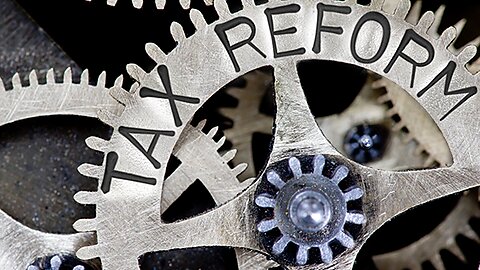Adam N. Michel
The Ways and Means Committee recently passed its “One, Big, Beautiful Bill” to extend many of the expiring 2017 tax cuts. But this opening bid falls short of delivering serious, pro-growth tax reform. It misses the opportunity to make the most important incentives for long-term growth permanent and includes at least 20 new or expanded tax subsidies, dramatically increasing the complexity of the tax code.
This tax bill will be combined with the rest of the House reconciliation package, which includes spending cuts and increases across health, energy, welfare, immigration, and defense. The full House of Representatives is expected to vote on the consolidated reconciliation package as soon as next week. The Senate will take it up next, likely making significant changes.
As written, the tax bill is not significantly pro-growth. The Tax Foundation estimates it would boost gross domestic product by just 0.6 percent in the long run. But most of that modest gain is driven by increased labor supply, not better productivity, higher wages, or more investment. In fact, the plan is expected to reduce investment, lower pre-tax wages, and have little impact on total national income.
If Republicans want to sell this bill as pro-growth reform that increases revenues and offsets some of President Trump’s damaging trade war, they need to prioritize permanent pro-growth reforms.
The Good Stuff That Could Be Better
The bill permanently extends many important elements of the 2017 Tax Cuts and Jobs Act, including lower individual income tax rates, a larger estate tax exemption, and reduced taxes on US businesses’ foreign earnings.
The bill also temporarily revives key investment deductions (called full expensing) for equipment, machinery, and research expenses and extends similar treatment to a new category of “qualified production property,” primarily manufacturing structures. While industry-specific carveouts are not ideal, permanent expensing for structures would be one of the most pro-investment additions lawmakers could make to the 2017 tax cuts. Unfortunately, all these provisions expire after 2029, eliminating their long-run benefits. Temporary tax cuts don’t meaningfully change long-run incentives to invest and grow businesses.
The bill also modestly reforms existing tax subsidies and repeals about 60 percent of the Inflation Reduction Act’s green energy tax credits, which have proven costly and inefficient. Some notable bright spots include an improved overall limit on itemized deductions, reforms to the corporate charitable deduction, and a series of stricter tax credit eligibility rules to reduce fraud and limit access by some non-US citizens or permanent residents. The bill could be improved by repealing a much longer list of existing tax preferences, including complete repeal of the Inflation Reduction Act.
The Bad Stuff
Unlike the 2017 tax bill, which broadened the tax base by reducing special interest subsidies to offset lower tax rates, this bill goes in the opposite direction. It adds or expands at least 20 tax credits, deductions, and exclusions. Each one entails fiscal costs, adds complexity, opens new avenues for tax avoidance, and delivers little in the way of long-term growth. Worse, the cost of these provisions crowds out the fiscal space needed to make the most pro-growth provisions permanent.
The bill includes a three-fold increase to the existing $10,000 state and local tax (SALT) deduction cap (which is likely to increase further), expanding a federal subsidy to high-income taxpayers, and creating incentives for high-tax states to raise their taxes further.
Trump’s campaign pledges to exempt from tax tips and overtime pay are included with modest guardrails, as is a $4,000 expansion to the deduction for the elderly, a nod to Trump’s request to eliminate taxes on Social Security. Each of these is a complex, targeted tax preference, given at the expense of lower tax rates for all Americans.
It sets up a new $5 billion scholarship tax credit, which, according to Cato’s Neal McCluskey, is unconstitutional, threatens deeper federal control of private education, and could stall the forward progress states have made on local education freedom. It also creates an investment account for kids, called a “money account for growth and advancement” (MAGA account). The accounts are temporarily seeded with $1,000 of taxpayer money, but it comes with a long list of complicated and counterintuitive strings attached. A better alternative would be universal savings accounts.
The bill also includes increases to tax credits for children, employer-provided childcare, paid family leave, and low-income housing. There are also new and expanded tax subsidies for student loan repayment, seafood processing, rural development, passthrough businesses, farmers, adoption costs, and biofuels, among other things.
Conclusion
The House Republican tax bill avoids some of the worst tax hikes that could have been included and makes a few welcome reforms. However, it falls short of what’s needed for meaningful, pro-growth tax reform.
To make the bill better, lawmakers should prioritize making full expensing permanent, eliminate or scale back the flood of new and expanded tax preferences, and go further in repealing costly and distortionary subsidies already in the tax code.
A tax code that is simpler, more neutral, and better aligned with long-term economic growth is still within reach, but this bill doesn’t get us there yet.
For a more in-depth list of all the provisions, see my Substack post: “Tax Bill Falls Short of Pro-Growth Reform.”


